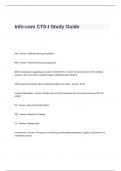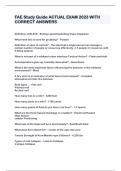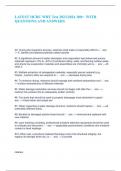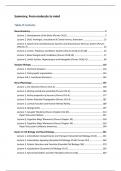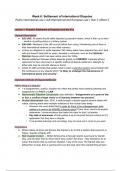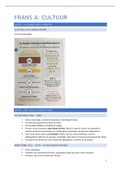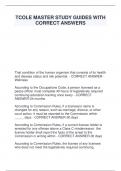Environment and Society : A
Critical Introduction
Inhoudsopgave
Chapter 1. Introduction.................................................................................................................................. 2
Chapter 2. Population and Scarcity................................................................................................................. 2
Chapter 3. Markets and Commodities............................................................................................................ 5
Chapter 4. Institutions and ‘The Commons’.................................................................................................... 8
Chapter 5. Environmental Ethics.................................................................................................................. 10
Chapter 6. Risks and Hazards........................................................................................................................ 13
Making informed decisions: risk communication..........................................................................................13
Risk as culture................................................................................................................................................14
Political economy of hazards.........................................................................................................................14
Chapter 7. Political Economy........................................................................................................................ 16
Chapter 8. Social Construction of Nature...................................................................................................... 20
The limits of constructivism: science, relativism and the Very Material World...........................................21
Chapter 9. Carbon Dioxide........................................................................................................................... 22
Institutions: climate free-riders and carbon cooperation (Chapter 4)..........................................................24
Markets: Trading more gases, buying less carbon (Chapter 3).....................................................................25
Political economy: who killed the atmosphere? (Chapter 7)........................................................................26
Conclusion......................................................................................................................................................26
,Chapter 1. Introduction
Anthropocene = metaphoric term (sometimes applied to current geological era)
where humans exert huge influence on environments all around the earth, but where
control of these environments and their complex ecologies is inevitably elusive.
ideas of ‘good’ policy.
Political ecology = approach to environmental issues that unites issues of ecology
with broadly defined political economy perspective
Reconciliation ecology = science of imagining, creating, and sustaining habitats,
productive environments and biodiversity in places used, travelled and inhabited by
human beings.
Rewilding = a practice of conservation where ecological functions and evolutionary
processes (which have probably existed in the past/before human influence) are
deliberately restored or created. Often requires reintroduction/restoration of large
predators to ecosystems
Rewilding contradictory position of transforming environment in ways that may preserve
environment is metaphor relationship between human and non-human world.
Book: interpretive tool and perspectives, dominant thinking models about environment-
society relationship. Two categories:
1. Environment aquatic, terrestrial and atmospheric non-human world.
2. Society humans, systems of culture, politics and economic exchange that govern
interrelationships.
Chapter 2. Population and Scarcity
Birth rate
Carrying capacity
Death rate
Demographic transition model
Ecological footprint
Exponential growth
Fertility rate
Forest transition theory
Green revolution
Induced intensification
Kuznets curve
Neo-malthusians
Zero population growth
Dramatic rate of population growth = questions
about limits of land, water and air to support city overpopulation.
T. R. Malthus:
o capacity of population to grow > than power of earth to provide resources. Growth is
effectively ‘geometric’ (exponential) = continued, non-linear increase (more steap) of
quantity, increasingly accelerated and compounded growth, with ecological
implications for scarcity.
o Food base for population arithmetic (linear) growth
, Geometric growth outpaces arithmetic growth = implications:
1. Wars, famine, destitution, disease to keep population in check
2. Policies promoting welfare of poor are counterproductive (encourage unnecessary
reproduction and resource waste
3. Key to averting periodic and inevitable resource crisis is moral code of self-restraint
(solution) many social and political biases
Neo-Malthusians use formulations to predict/calculate relationship population and
environmental degradation. But many more perspectives, critiques and opinions.
Neo-Malthusians = present-day adherents to Malthusian (19th century) perceptions
regarding population growth outstrips limited natural resources and presents single
greaters driver of environmental degradation and crisis).
Kuznets Curve (Environmental) = based in theory that income inequality will increase
during economic development and decrease after reaching state of overall affluence,
this theory predicts that environmental impacts rise during development, only to fall
after economy matures.
Proponents of Kuznets Curve forest transition theory = model that predicts a period of
deforestation during development (urbanization, deforestation, affluence) because land
cleared for agriculture, but followed by return of forest when economy changes and
population outmigrates and/or becomes conservation-oriented. Replace trees on empty
rural areas.
Carrying Capacity = theoretical limit of population that a system can sustain. Population
growth has often led to growing carrying capacity (innovation). Carrying capacity and
ecological footprint used as indices to think about impact human individuals and
populations.
Ecological footprint = theoretical spatial extent of earth’s surface required to sustain
individual, group, system, organization, index of environmental impact. To estimate the total
area of productive land and water required to produce resources for and assimilate the
waste from a given population multiple scales.
More people = more food induced intensification = a thesis predicting that where
agricultural populations grow, demands for food lead to technological innovations resulting
in increased food production on the same amount of available land. E.g. Green Revolution =
suite of technological innovations, developed in universities/international centres, which
were applied to agriculture between 1950s and 1980s and increased agricultural yields
dramatically, but raised chemical inputs (fertilizers, pesticides) and increased demands for
water and machinery.
Circulation and global production chain of agricultural products makes assessing impact of
local, regional and global populations extremely difficult. Driving western populations impact
on Global South.
Rate of population growth has fallen in past few years is population a social driver of
environmental change or the product/outcome of social and environmental
circumstances/conditions? Global shift comes from demographic history 19 th and 20th
century Europe (< 1800: stable // 1800s: high growths levels that slowly level off).
Critical Introduction
Inhoudsopgave
Chapter 1. Introduction.................................................................................................................................. 2
Chapter 2. Population and Scarcity................................................................................................................. 2
Chapter 3. Markets and Commodities............................................................................................................ 5
Chapter 4. Institutions and ‘The Commons’.................................................................................................... 8
Chapter 5. Environmental Ethics.................................................................................................................. 10
Chapter 6. Risks and Hazards........................................................................................................................ 13
Making informed decisions: risk communication..........................................................................................13
Risk as culture................................................................................................................................................14
Political economy of hazards.........................................................................................................................14
Chapter 7. Political Economy........................................................................................................................ 16
Chapter 8. Social Construction of Nature...................................................................................................... 20
The limits of constructivism: science, relativism and the Very Material World...........................................21
Chapter 9. Carbon Dioxide........................................................................................................................... 22
Institutions: climate free-riders and carbon cooperation (Chapter 4)..........................................................24
Markets: Trading more gases, buying less carbon (Chapter 3).....................................................................25
Political economy: who killed the atmosphere? (Chapter 7)........................................................................26
Conclusion......................................................................................................................................................26
,Chapter 1. Introduction
Anthropocene = metaphoric term (sometimes applied to current geological era)
where humans exert huge influence on environments all around the earth, but where
control of these environments and their complex ecologies is inevitably elusive.
ideas of ‘good’ policy.
Political ecology = approach to environmental issues that unites issues of ecology
with broadly defined political economy perspective
Reconciliation ecology = science of imagining, creating, and sustaining habitats,
productive environments and biodiversity in places used, travelled and inhabited by
human beings.
Rewilding = a practice of conservation where ecological functions and evolutionary
processes (which have probably existed in the past/before human influence) are
deliberately restored or created. Often requires reintroduction/restoration of large
predators to ecosystems
Rewilding contradictory position of transforming environment in ways that may preserve
environment is metaphor relationship between human and non-human world.
Book: interpretive tool and perspectives, dominant thinking models about environment-
society relationship. Two categories:
1. Environment aquatic, terrestrial and atmospheric non-human world.
2. Society humans, systems of culture, politics and economic exchange that govern
interrelationships.
Chapter 2. Population and Scarcity
Birth rate
Carrying capacity
Death rate
Demographic transition model
Ecological footprint
Exponential growth
Fertility rate
Forest transition theory
Green revolution
Induced intensification
Kuznets curve
Neo-malthusians
Zero population growth
Dramatic rate of population growth = questions
about limits of land, water and air to support city overpopulation.
T. R. Malthus:
o capacity of population to grow > than power of earth to provide resources. Growth is
effectively ‘geometric’ (exponential) = continued, non-linear increase (more steap) of
quantity, increasingly accelerated and compounded growth, with ecological
implications for scarcity.
o Food base for population arithmetic (linear) growth
, Geometric growth outpaces arithmetic growth = implications:
1. Wars, famine, destitution, disease to keep population in check
2. Policies promoting welfare of poor are counterproductive (encourage unnecessary
reproduction and resource waste
3. Key to averting periodic and inevitable resource crisis is moral code of self-restraint
(solution) many social and political biases
Neo-Malthusians use formulations to predict/calculate relationship population and
environmental degradation. But many more perspectives, critiques and opinions.
Neo-Malthusians = present-day adherents to Malthusian (19th century) perceptions
regarding population growth outstrips limited natural resources and presents single
greaters driver of environmental degradation and crisis).
Kuznets Curve (Environmental) = based in theory that income inequality will increase
during economic development and decrease after reaching state of overall affluence,
this theory predicts that environmental impacts rise during development, only to fall
after economy matures.
Proponents of Kuznets Curve forest transition theory = model that predicts a period of
deforestation during development (urbanization, deforestation, affluence) because land
cleared for agriculture, but followed by return of forest when economy changes and
population outmigrates and/or becomes conservation-oriented. Replace trees on empty
rural areas.
Carrying Capacity = theoretical limit of population that a system can sustain. Population
growth has often led to growing carrying capacity (innovation). Carrying capacity and
ecological footprint used as indices to think about impact human individuals and
populations.
Ecological footprint = theoretical spatial extent of earth’s surface required to sustain
individual, group, system, organization, index of environmental impact. To estimate the total
area of productive land and water required to produce resources for and assimilate the
waste from a given population multiple scales.
More people = more food induced intensification = a thesis predicting that where
agricultural populations grow, demands for food lead to technological innovations resulting
in increased food production on the same amount of available land. E.g. Green Revolution =
suite of technological innovations, developed in universities/international centres, which
were applied to agriculture between 1950s and 1980s and increased agricultural yields
dramatically, but raised chemical inputs (fertilizers, pesticides) and increased demands for
water and machinery.
Circulation and global production chain of agricultural products makes assessing impact of
local, regional and global populations extremely difficult. Driving western populations impact
on Global South.
Rate of population growth has fallen in past few years is population a social driver of
environmental change or the product/outcome of social and environmental
circumstances/conditions? Global shift comes from demographic history 19 th and 20th
century Europe (< 1800: stable // 1800s: high growths levels that slowly level off).


